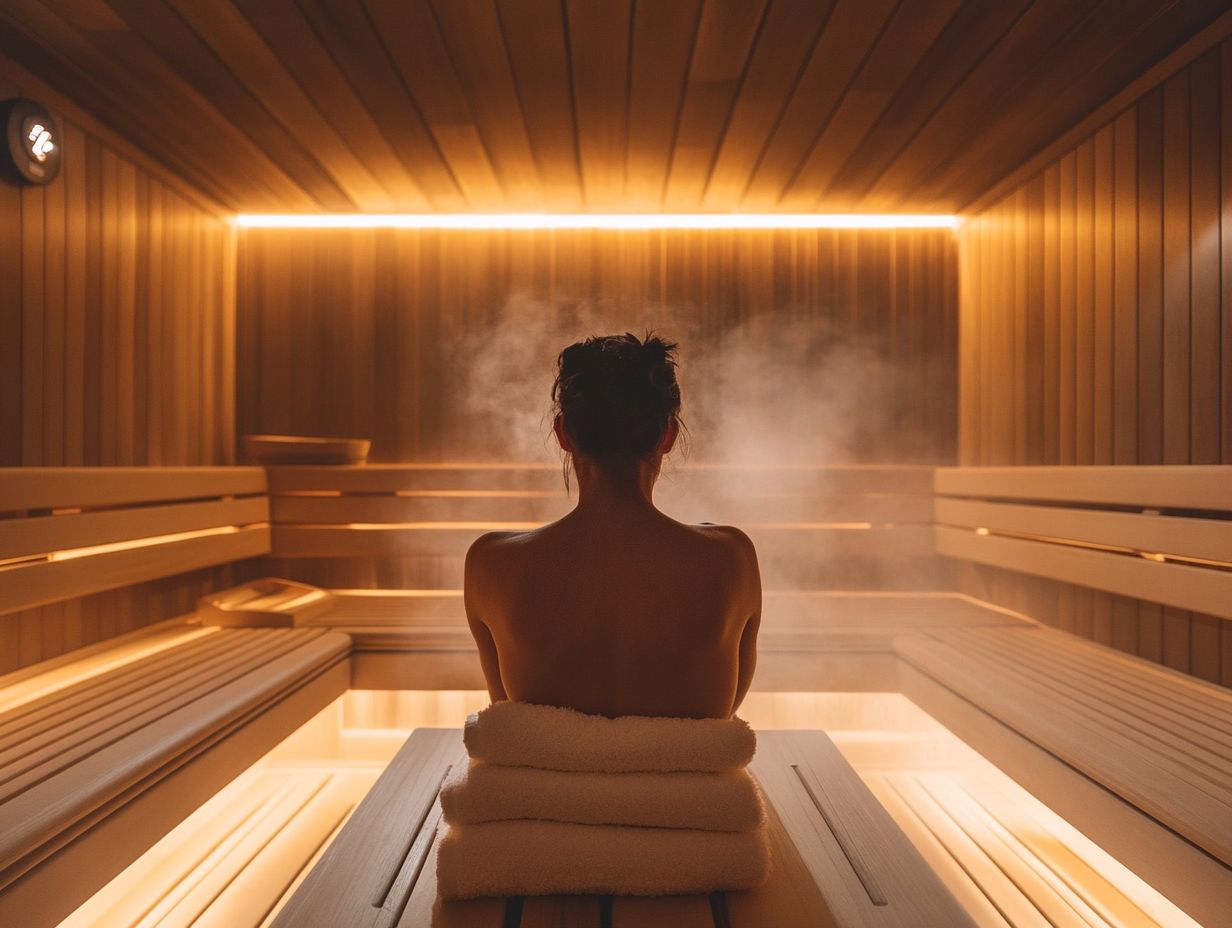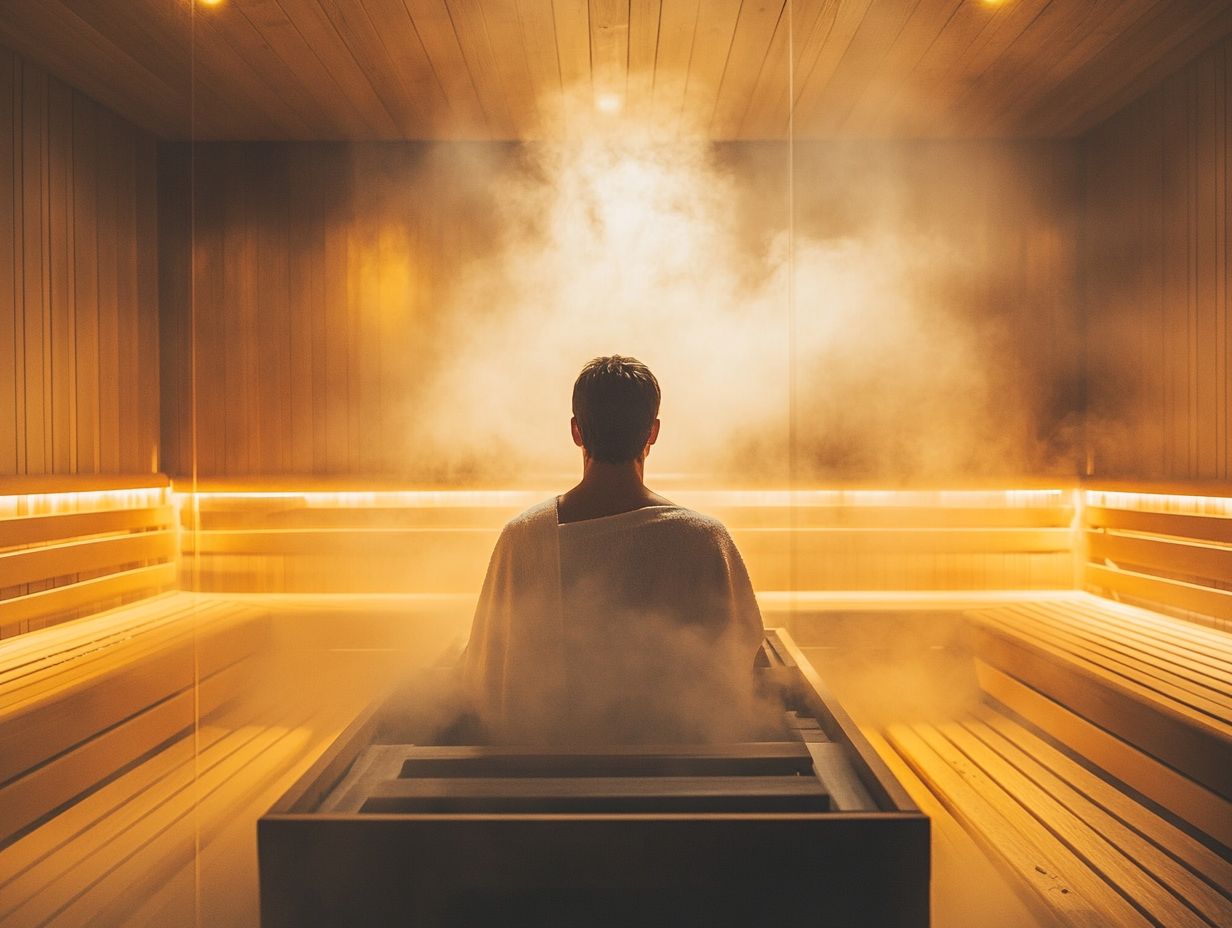What Should You Wear in a Sauna?
Saunas have been revered for their comforting warmth and an array of health benefits.
Whether you seek relaxation, detoxification, or just a tranquil moment for yourself, grasping the nuances of sauna use is essential.
From the perks of regular sessions to what attire is appropriate, choosing the ideal sauna type, and adhering to proper etiquette, this guide encompasses everything necessary for a safe and fulfilling experience.
Don t wait dive in now and discover how to make the most of your sauna experience!
Contents
Key Takeaways:

- Choose natural and breathable fabrics for your sauna attire to allow for proper ventilation and avoid overheating.
- Be mindful of sauna etiquette, such as using a towel to sit on and keeping conversations quiet to respect others’ relaxation.
- Take necessary precautions in different types of saunas, such as controlling the temperature in traditional saunas and staying hydrated in infrared saunas.
What is a Sauna?
A sauna is your private oasis, a small room or house designed for indulging in dry or wet heat sessions. With roots in Finland, saunas have woven themselves into the cultural fabric of many societies, including those of Japan and Turkey.
In a typical sauna, you can revel in the benefits of natural heat exposure, often enhanced with essential oils, transforming it into a sanctuary for relaxation and rejuvenation. To ensure a safe experience, consider reviewing sauna safety: creating a personal plan. Traditional saunas are crafted from wood, while modern options use special heaters to provide deep warmth.
The historical significance of saunas stretches back centuries, serving not just as a means of physical cleansing but as vibrant communal spaces for social interaction and cultural rituals. Explore how cultures around the world celebrate their unique sauna styles!
Among the many sauna varieties, infrared options have gained traction for their ability to penetrate deeply into the skin, amplifying health benefits. By incorporating essential oils like eucalyptus or lavender, you can elevate your sauna experience into a holistic retreat, captivating your senses and enhancing your well-being.
With advancements in sauna technology, you now have the freedom to explore a range of sensory journeys, ensuring that each session is uniquely tailored to your desires.
Health Benefits of Saunas
Using a sauna offers a wealth of benefits that enrich both physical and mental well-being, earning its esteemed status across diverse cultures.
Regular sauna sessions can boost your cardiovascular health, alleviate stress, and foster relaxation. As you immerse yourself in the soothing warmth, your body sweats out toxins, promoting hygiene and improving your skin’s condition.
This practice stands as a cornerstone of holistic wellness, inviting you to experience a deeper sense of vitality and rejuvenation.
The benefits of using a sauna are truly remarkable. You ll experience everything from improved circulation and enhanced cardiovascular function to greater mental clarity and stress relief. Regular sessions can significantly enhance your overall comfort and well-being, providing a serene escape from the chaotic pace of modern life.
Along with promoting detoxification through increased sweat production, you ll find that muscle relaxation improves, making sauna use an excellent remedy for post-exercise recovery. Many users have reported lower blood pressure over time, highlighting the cardiovascular perks that come with routine sauna visits.
On the mental health side, the soothing heat works wonders for stress reduction, allowing you to unwind and recharge, leading to elevated moods and a more balanced perspective on life. By incorporating sauna sessions into your wellness routine, you may discover a holistic approach to health that nurtures both your body and mind.
Ready to relax? Book your sauna session today!
What to Wear in a Sauna

Choosing what to wear in a sauna greatly influences your comfort and enjoyment. It also helps you adhere to proper etiquette. Some individuals prefer to embrace the sauna experience without clothes, allowing their skin to breathe freely in the heat. Others lean towards breathable fabrics or accessories like cotton towels or swimsuits.
Selecting the right clothing improves your experience and keeps you hygienic, whether you re in a public or private sauna.
Best Clothing for Your Sauna Experience
Cotton towels and breathable swimsuits are your best options for maximizing comfort while maintaining hygiene. Your choice of whether to wear a swimsuit, go without clothes, or wrap yourself in a towel often depends on personal preference and the sauna’s setting be it public or private.
Opting for breathable cotton enhances the experience, allowing your skin to breathe while efficiently absorbing sweat. Quick-drying swimsuits can also offer a balance between practicality and modesty, especially in certain environments.
Etiquette is crucial. Consider the expectations of others and respect personal boundaries. Choosing natural fibers enhances your comfort and honors the sauna’s tradition of relaxation and wellness.
By being mindful of both comfort and etiquette, you can significantly enrich your sauna experience.
Considerations for Different Types of Saunas
When contemplating your attire for various types of saunas, understanding the differences between traditional and infrared saunas is essential for optimal comfort and hygiene.
Traditional saunas provide a dry heat experience that promotes significant sweating, while infrared saunas use heat from light to warm the body. This distinction greatly influences how you should dress for your session, ensuring you remain comfortable while adhering to hygiene standards. For more on this topic, check out sauna safety: a holistic approach.
Traditional vs. Infrared Saunas
Traditional and infrared saunas offer distinct heating methods and user experiences, each presenting unique benefits rooted in cultural practices. Traditional saunas rely on heated stones and air to generate high humidity and boost sweat production. Infrared saunas, on the other hand, utilize radiant heat to penetrate the skin more effectively, leading to different sensations and health advantages.
These differing approaches shape your physical experience during sessions and influence the overall therapeutic benefits you can expect. If you appreciate the ambiance and ritualistic elements of traditional saunas, you may find comfort in the steam-filled atmosphere, central to social gatherings across cultures for centuries. To ensure a safe and enjoyable experience, consider reviewing sauna safety tips before your first session.
If you’re seeking targeted relaxation or detoxification, infrared saunas might be more appealing. They are often celebrated for providing profound relaxation without the intense heat typically associated with traditional saunas. This cultural significance highlights how your choice between these two types can enhance your lifestyle and align with your health goals. Additionally, understanding sauna safety is crucial to ensure a safe and beneficial experience.
Tips for Sauna Etiquette

Understanding sauna etiquette is crucial for enhancing your experience, whether you’re in a public facility or a private retreat. This knowledge significantly impacts your comfort and hygiene.
To maximize your enjoyment, remember these key etiquette tips:
- Shower before entry to maintain cleanliness,
- Respect the personal space of others, and
- Adhere to clothing norms as outlined in sauna safety gear guidelines.
By following these principles, you can ensure that everyone enjoys the sauna’s soothing benefits without any discomfort or awkwardness.
Proper behavior and hygiene in a shared sauna space are crucial for ensuring that you and all other visitors feel comfortable while enjoying the experience. This means showering before entry, using towels to sit on, and engaging in respectful interactions with those around you. All of these contribute to a pleasant atmosphere.
Beyond these essential practices, it’s vital to respect personal space, especially in crowded saunas where everyone has different comfort levels. To ensure safety, it’s also important to understand sauna safety by avoiding loud conversations and the use of electronic devices to maintain a serene environment where relaxation reigns supreme.
Keeping the sauna free of personal items and trash reflects your individual responsibility. It also elevates the collective experience for everyone. By embracing these behavioral norms, you play a key role in creating a harmonious atmosphere. For more on how to ensure a safe and enjoyable experience, check out sauna safety: a comprehensive overview. This fosters positive relationships and mindful interactions in this shared sanctuary.
Safety Precautions in a Sauna
Safety precautions in a sauna are essential to prevent overheating and mitigate any risks associated with spending too much time in the heat. It s important for you to understand your personal limits, stay hydrated, and take breaks as needed. Enjoy your sauna sessions to the fullest by staying hydrated and knowing your limits!
By doing so, you can ensure both your physical comfort and overall well-being.
Preventing Overheating and Other Risks
Preventing overheating and other risks in a sauna requires you to pay attention to your comfort levels and stick to the recommended guidelines. Being mindful of how long you’ve been in the sauna and recognizing the signs of excessive heat can help you enjoy its benefits without compromise.
To maintain a safe and pleasurable experience, it’s essential to limit your sauna sessions to about 15-20 minutes at a time. Watch for any signs of overheating, such as dizziness, nausea, intense sweating, or headaches. These are signals you should never ignore. For more information on staying safe, check out sauna safety: planning for the unexpected.
Staying hydrated before and after your sauna visit is crucial for regulating your body temperature. Taking breaks between sessions allows your body to cool down, ensuring that you can use the sauna comfortably. Additionally, being aware of sauna safety regulations can enhance your comfort and safety by adjusting the temperature, like stepping away from the heat source.
Frequently Asked Questions

What Should You Wear in a Sauna?
The most common attire for a sauna is a towel or a swimsuit. However, some people may choose to go nude.
Can You Wear Regular Clothing in a Sauna?
No, it is not recommended to wear regular clothing in a sauna as it can become uncomfortable and may not allow your body to sweat properly.
Is it Necessary to Wear a Towel in a Sauna?
It is not necessary to wear a towel in a sauna, but it is considered good etiquette to bring one to sit on and to dry off with afterwards.
Can You Wear Accessories in a Sauna?
It is not recommended to wear accessories such as jewelry or glasses in a sauna as they may become hot and uncomfortable. Additionally, they may interfere with your body’s ability to sweat properly.
Should You Wear Shoes in a Sauna?
It is not necessary to wear shoes in a sauna, but you may want to bring a pair of flip-flops or sandals to wear when walking to and from the sauna. This helps prevent slipping and protects your feet from any hot surfaces.
What Should You Bring to Wear in a Sauna?
It is recommended to bring a towel, a swimsuit or comfortable clothing, and flip-flops or sandals to wear in a sauna. Some saunas may also provide towels or robes for guests to use.
If you have any further questions or would like to share your sauna experiences, feel free to reach out!






